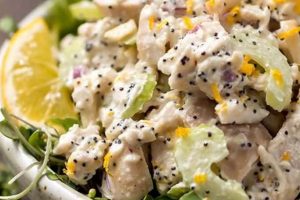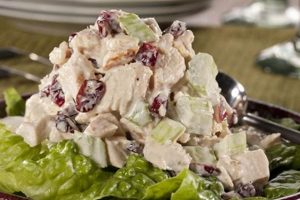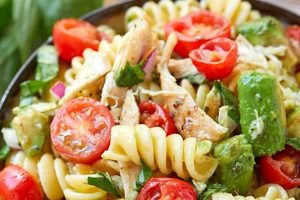A refreshing and flavorful variation of a classic dish incorporates fruit such as crisp apples and sweet grapes, adding a textural and flavor complexity to the creamy, savory base. This combination offers a balance of sweet and savory notes, often complemented by nuts and a light, tangy dressing.
The inclusion of fruit elevates this dish beyond a simple protein source, offering nutritional benefits from the added vitamins and antioxidants present in apples and grapes. Historically, fruit in savory dishes signifies both resourcefulness and a desire for balanced flavors. This preparation often features in light lunches, picnics, and as a filling for sandwiches or wraps, demonstrating its adaptability and widespread appeal.
Exploration of specific ingredient combinations, dressing variations, and complementary side dishes will further illustrate the versatility and culinary possibilities offered by this appealing blend of flavors and textures.
Tips for Preparing a Chicken Salad with Apples and Grapes
Optimizing ingredient selection and preparation techniques enhances the final dish, creating a balanced and flavorful experience.
Tip 1: Use rotisserie chicken for convenience and flavor depth. Alternatively, poaching or baking chicken breasts yields a tender, easily shreddable result.
Tip 2: Opt for crisp, tart apples such as Granny Smith or Honeycrisp. These varieties maintain their texture and provide a counterpoint to the richness of the chicken and dressing.
Tip 3: Red or green seedless grapes offer sweetness and a pleasing pop of flavor. Halving larger grapes ensures even distribution throughout the salad.
Tip 4: Incorporate toasted pecans or walnuts for added crunch and a complementary nutty flavor. Almonds or slivered pistachios offer alternative textural and flavor dimensions.
Tip 5: A mayonnaise-based dressing provides a creamy foundation. Greek yogurt offers a lighter alternative, while a vinaigrette contributes a tangy element. Flavor can be enhanced with Dijon mustard, lemon juice, or fresh herbs.
Tip 6: Chill the salad for at least 30 minutes before serving. Chilling allows the flavors to meld and enhances the refreshing qualities of the dish.
Tip 7: Serve the salad on bread, crackers, croissants, or lettuce cups for varied presentations. This adaptable dish also serves as a filling for wraps or sandwiches.
Careful consideration of these elements ensures a well-balanced and enjoyable culinary experience.
By understanding these guidelines, one can create a chicken salad with apples and grapes that is both flavorful and satisfying.
1. Ingredient Balance
Ingredient balance is crucial for a successful chicken salad incorporating apples and grapes. A harmonious blend of flavors and textures elevates this dish beyond a simple combination of ingredients. Proper proportions ensure that no single element overwhelms the others, creating a cohesive and enjoyable culinary experience.
- Protein (Chicken):
Chicken provides the foundational protein base. The amount of chicken influences the overall heartiness of the salad. Too much can make it dense, while too little may leave it lacking substance. Consider the desired consistency and adjust the chicken-to-other-ingredient ratio accordingly. Using shredded or diced chicken allows for even distribution and integration with other components.
- Fruit (Apples and Grapes):
The sweetness and texture of apples and grapes provide a refreshing counterpoint to the savory chicken. Balancing the quantity of fruit is essential. Overabundance can result in an overly sweet or watery salad, whereas insufficient amounts may diminish the intended flavor and textural contrast. Dicing apples and halving grapes creates bite-sized pieces that distribute evenly throughout the salad.
- Binding Agent/Dressing:
Mayonnaise, yogurt, or a vinaigrette bind the ingredients and contribute to the overall flavor profile. The amount of binding agent impacts the salad’s creaminess and moisture content. Too much can make the salad heavy, while too little can leave it dry and crumbly. The choice of binding agent also affects the overall flavor profile, whether creamy, tangy, or light. Experimentation with different binding agents allows for customization based on personal preference.
- Complementary Ingredients:
Nuts, celery, onions, and herbs offer textural and flavor enhancements. These additions, while not essential, contribute layers of complexity. Moderation is key; excessive amounts of these ingredients can overwhelm the primary flavors of chicken, apple, and grape. Strategic inclusion of complementary ingredients, such as toasted nuts for crunch or finely diced celery for subtle vegetal notes, elevates the overall sensory experience.
Achieving a desirable balance among these elements ensures a chicken salad with apples and grapes that offers a harmonious blend of flavors, textures, and nutritional value. Consideration of these factors elevates the dish from a basic combination of ingredients to a well-crafted culinary creation.
2. Textural Contrast
Textural contrast significantly contributes to the sensory appeal of chicken salad with apples and grapes. The interplay of different textures creates a more engaging and enjoyable eating experience. Understanding the various textural elements and their interplay is key to crafting a well-balanced and satisfying dish.
- Chicken:
The chicken, typically shredded or diced, provides a tender, fibrous foundation. Its texture offers a neutral backdrop against which the other ingredients’ contrasting textures stand out. The preparation method influences the chicken’s texture; poached chicken tends to be more tender than baked or rotisserie chicken.
- Apples:
Apples introduce a crisp, juicy element. The variety of apple influences the degree of crispness; Granny Smith apples offer a sharper, firmer bite than Honeycrisp. Dicing the apples into appropriately sized pieces ensures a pleasant textural experience, avoiding overly large or small pieces.
- Grapes:
Grapes contribute a smooth, juicy burst. Their texture contrasts with both the tender chicken and the crisp apple. Halving or quartering larger grapes ensures consistent bite sizes and prevents them from overwhelming the other textural elements. The choice between green and red grapes primarily affects sweetness and visual appeal rather than texture.
- Nuts & Add-ins:
Optional additions like toasted nuts (walnuts, pecans, almonds) or celery introduce a crunchy dimension, further enhancing the textural complexity. These additions create points of interest within the salad, providing contrasting sensations against the softer elements. The quantity of these additions should be balanced to avoid overwhelming the other textures.
The successful combination of these textural elements elevates the chicken salad with apples and grapes. The contrast between the tender chicken, crisp apple, juicy grapes, and potentially crunchy nuts creates a dynamic and satisfying sensory experience. This interplay of textures is crucial to the overall enjoyment of the dish.
3. Flavor Profiles
Flavor profiles play a critical role in the overall enjoyment of chicken salad with apples and grapes. A successful recipe balances sweet, savory, tangy, and potentially spicy notes to create a complex and harmonious taste experience. The interplay of these flavors contributes significantly to the dish’s appeal.
The inherent savory flavor of chicken forms the base. This savoriness provides a neutral canvas against which the other flavors interact. Rotisserie chicken contributes a deeper, roasted flavor, while poached chicken offers a cleaner taste.
Apples contribute sweetness and tartness. The specific apple variety influences the flavor profile. Granny Smith apples offer a sharp tartness, while Honeycrisp apples lean towards a balanced sweetness. This tartness or sweetness interacts with the savory chicken, creating a balanced flavor dynamic. The quantity of apple influences the overall sweetness and tartness of the salad.
Grapes introduce sweetness and a subtle juiciness. Green grapes tend to be slightly more tart, while red grapes offer a richer sweetness. This sweetness complements both the savory chicken and the apple’s tartness or sweetness. Similar to apples, the quantity of grapes influences the overall sweetness of the salad.
The dressing adds another layer of flavor complexity. Mayonnaise contributes a creamy richness, while Greek yogurt offers a tangy lightness. A vinaigrette introduces acidity and brightness. Incorporating ingredients such as Dijon mustard, lemon juice, or herbs further enhances the flavor profile, adding depth and nuance.
Finally, optional add-ins like nuts or celery introduce textural variation and subtle flavor nuances. Toasted nuts contribute a nutty richness and crunch, while celery adds a mild vegetal note. These additions, while not essential, can enhance the overall flavor experience.
A well-balanced flavor profile is essential for a successful chicken salad with apples and grapes. The interplay of savory, sweet, and tangy elements creates a dynamic and enjoyable taste experience. Careful consideration of each ingredient’s contribution to the overall flavor profile is crucial for creating a harmonious and delicious dish.
4. Nutritional Value
Nutritional value represents a significant consideration within the context of a chicken salad recipe incorporating apples and grapes. This dish offers a combination of macronutrients and micronutrients contributing to a balanced dietary intake. Analyzing the nutritional components provides valuable insights into the health benefits and overall dietary contribution of this meal.
- Lean Protein (Chicken):
Chicken serves as a primary source of lean protein, essential for muscle building, repair, and overall body function. The protein content contributes to satiety, reducing the likelihood of overeating. Choosing lean chicken breast further maximizes the protein benefit while minimizing fat intake.
- Dietary Fiber (Apples and Grapes):
Both apples and grapes contribute dietary fiber, promoting digestive health and regularity. Fiber also plays a role in managing blood sugar levels and promoting feelings of fullness. The skin of both fruits contains a significant portion of the fiber, so leaving the skin on maximizes this nutritional benefit.
- Vitamins and Minerals (Apples and Grapes):
Apples and grapes offer a variety of vitamins and minerals, including vitamin C, vitamin K, and potassium. These micronutrients play essential roles in immune function, bone health, and electrolyte balance. The variety of apple or grape can influence the specific vitamin and mineral content.
- Healthy Fats (Optional Nuts/Seeds and Dressing):
Incorporating nuts or seeds adds healthy fats, contributing to satiety and providing essential fatty acids. However, portion control is essential due to the caloric density of nuts and seeds. The choice of dressing also influences fat content; opting for lighter dressings like vinaigrettes or those based on Greek yogurt can reduce overall fat and calorie intake compared to mayonnaise-based dressings.
The combined nutritional contributions of chicken, apples, grapes, and optional additions create a dish that offers a balance of macronutrients and micronutrients. Understanding these nutritional components allows for informed choices regarding ingredient selection and portion sizes, maximizing the health benefits of this versatile dish. This nutritional profile makes the chicken salad with apples and grapes a potentially valuable component of a balanced diet.
5. Serving Options
Serving options significantly influence the versatility and presentation of chicken salad incorporating apples and grapes. The chosen method of service impacts both the perceived formality and the overall dining experience. Exploring various serving options highlights the adaptability of this dish to diverse occasions and culinary preferences.
- Bread-Based Vessels:
Serving the salad on bread, croissants, or rolls creates a classic sandwich or slider presentation. This option provides portability and convenience, making it suitable for casual lunches, picnics, or quick meals. The type of bread influences the overall flavor and texture; a flaky croissant offers a buttery richness, while whole-wheat bread provides a more substantial, nutty flavor.
- Crackers and Wraps:
Crackers or wraps offer a lighter alternative to bread, emphasizing the salad as the central element. Crackers provide a crispy contrast to the creamy salad, while wraps allow for customization with various fillings and flavors. This option suits appetizers, snacks, or light lunches, offering a less carb-heavy alternative to sandwiches.
- Green Vessels:
Utilizing lettuce cups or endive spears as vessels creates a refreshing, low-carbohydrate presentation. This option aligns with health-conscious preferences, emphasizing the fresh ingredients of the salad. The crispness of the lettuce complements the creamy salad, adding a textural dimension. This serving style is often preferred for lighter meals or as part of a larger spread.
- Standalone Salads:
Presenting the chicken salad as a standalone salad, often accompanied by a simple green salad, elevates the dish to a more substantial meal. This option allows the flavors and textures of the salad to shine, showcasing the balance of ingredients. Adding complementary elements like toasted nuts or dried cranberries further enhances the visual appeal and flavor profile, making it suitable for lunch or a light dinner.
The diverse range of serving options highlights the adaptability of chicken salad with apples and grapes. From casual sandwiches to elegant appetizers, the chosen presentation influences the overall dining experience. Consideration of these serving options allows for customization to suit various occasions and individual preferences, demonstrating the versatility of this classic dish.
Frequently Asked Questions
This section addresses common inquiries regarding chicken salad prepared with apples and grapes, providing concise and informative responses.
Question 1: What type of apple is best suited for this salad?
Crisp, tart apples such as Granny Smith or Honeycrisp are recommended. These varieties maintain their texture and provide a desirable flavor contrast to the other ingredients.
Question 2: Can alternative fruits be used in this recipe?
While apples and grapes provide a classic flavor combination, other fruits like dried cranberries, chopped pears, or mandarin oranges can be incorporated for variation, though this would alter the fundamental flavor profile.
Question 3: What is the best way to prevent the apples from browning?
Tossing diced apples with a small amount of lemon juice helps prevent oxidation and maintains their fresh appearance. This also adds a subtle tangy note that complements the other flavors.
Question 4: How long can this chicken salad be stored in the refrigerator?
Properly stored in an airtight container, the salad should be consumed within three to five days to maintain optimal quality and safety.
Question 5: Can this recipe be adapted for those seeking lower-fat options?
Substituting Greek yogurt for mayonnaise, using lean chicken breast, and reducing the quantity of nuts or omitting them entirely creates a lighter version while preserving essential flavors.
Question 6: What are some suitable accompaniments for this chicken salad?
This salad pairs well with various accompaniments, including mixed greens, crusty bread, crackers, or fruit slices. These pairings provide complementary flavors and textures, enhancing the overall dining experience.
Understanding these commonly addressed points provides a comprehensive foundation for preparing and enjoying chicken salad with apples and grapes.
Further exploration of variations and serving suggestions allows for customization and personalization of this versatile dish.
Conclusion
Analysis of chicken salad enhanced with apples and grapes reveals a dish offering nuanced flavor profiles and textural complexity. Careful ingredient selection, balanced proportions, and considered preparation methods contribute significantly to the final product. From the tartness of apples to the sweetness of grapes, each element plays a crucial role in the overall sensory experience. Nutritional considerations further underscore the dish’s value as a balanced meal option.
Culinary exploration beyond standard preparations reveals the adaptability of this classic combination. Continued experimentation with ingredient variations, dressings, and serving styles promises further evolution and enjoyment of this versatile dish, enriching culinary experiences and offering a refreshing departure from traditional chicken salad preparations.






